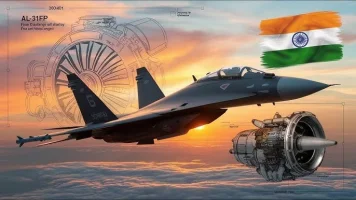- Views: 5K
- Replies: 26
The Indian Air Force (IAF) is confident that its upcoming upgrades to the Sukhoi Su-30MKI fighter jet fleet will provide a decisive edge over potential acquisitions by the Pakistan Air Force (PAF), specifically the Chinese J-35A stealth aircraft, according to a recent statement by an IAF official.
The official suggested that while the J-35A incorporates design elements to reduce visibility to radar, it may not possess the true all-aspect stealth capabilities required to effectively challenge an Su-30MKI enhanced with the indigenous Virupaksha radar and Astra MkIII missile system.
The Su-30MKI, currently the backbone of India's fighter aircraft inventory and license-produced by Hindustan Aeronautics Limited (HAL), is slated for a significant enhancement package dubbed the "Super Sukhoi" program.
A key feature of this upgrade is the introduction of the Virupaksha radar. This advanced Active Electronically Scanned Array (AESA) radar, developed domestically, utilizes Gallium Nitride (GaN) technology and boasts around 2,400 Transmit/Receive Modules (TRMs).
This radar system, when combined with the extended-range Astra MkIII air-to-air missile, is expected to present a formidable deterrent to potential adversaries.
Highlighting the Virupaksha's advanced features, the IAF official noted its capability to detect low-observable aircraft like the J-35A at significant distances, potentially between 300 and 400 kilometres for targets of comparable size.
"The Chinese J-35A might have stealth measures to cover its radar signature, but it’s not a stealth jet where a pilot will feel comfortable taking on the upgraded Sukhoi-30 once it’s ready," the official remarked.
The radar's sophisticated electronic scanning, long reach, and enhanced resistance to electronic countermeasures are expected to provide superior situational awareness, functioning almost like a smaller Airborne Warning and Control System (AWACS).
This confidence is partly rooted in the Virupaksha radar's design, reportedly an enlarged version derived from the Defence Research and Development Organisation's (DRDO) Uttam AESA radar program.
Its GaN semiconductor technology allows for greater power efficiency and detection range compared to older radar types. This is anticipated to help counter stealth designs primarily optimized to evade higher-frequency radar bands (like X-band), where the J-35A's radar cross-section (RCS) reduction is likely most effective.
The official expressed belief that the Virupaksha will be capable of not just detecting but also reliably tracking the J-35A, thereby neutralizing a significant portion of its stealth advantage.
Working in tandem with the powerful radar will be the Astra MkIII missile, also known as "Gandiva." This indigenous beyond-visual-range (BVR) missile is propelled by a cutting-edge solid fuel ducted ramjet (SFDR) engine, enabling it to achieve hypersonic speeds (reportedly up to Mach 4.5) and strike targets at ranges exceeding 300-350 kilometres. This range potentially surpasses that of the Chinese PL-15 missile (estimated around 200+ km).
The Astra MkIII's extended "No Escape Zone" – the area where a target cannot kinetically evade the missile – is designed to ensure a high probability of interception against targets like the J-35A attempting BVR engagement.
The official drew a comparison with the PAF's current inventory, such as the J-10CE fighter. This aircraft is an export variant of China's J-10, equipped with what the official described as comparatively less capable systems, including the KLJ-10 AESA radar and the PL-15E missile, the export version reportedly limited to a 145 km range.
"The Chinese will not be sharing the best of their technology with Pakistan, just like they did with the J-10," the official commented, implying similar export limitations might apply to any potential J-35A deal.
The comprehensive "Super Sukhoi" initiative aims to elevate the Su-30MKI to a '4.5+ generation' standard. Beyond the Virupaksha radar, it includes integrating new infrared search and track (IRST) systems and a suite of Indian-developed armaments, including the Astra missile family.
The first phase of this upgrade is planned for 84 aircraft out of the IAF's fleet of roughly 260 Su-30MKIs, carrying an estimated cost of ₹65,000 crore (approximately USD 7.8 billion). Reports suggest the Su-30MKI's large airframe can accommodate the new Virupaksha radar system without requiring major structural alterations.
Ultimately, the IAF official conveyed strong assurance in the upgraded platform's capabilities, extending beyond just the technology. "The combination of Virupaksha and Astra MkIII will deter any Pakistani J-35A pilot from trying to test Chinese stealth claims," he stated, suggesting the potent technological pairing could create a significant psychological deterrent in any potential aerial confrontation.

